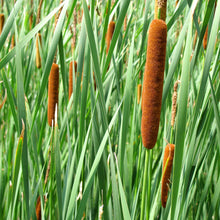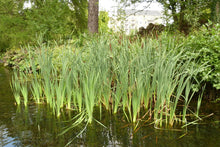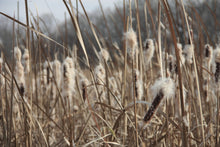Typha latifolia
Cattails are a cherished, lush sight in North American marches and ditches. This semi aquatic perennial grows from aggressive rhizomes producing long, flat grass-like leaves that have countless ethnobotanical uses since time immemorial. Abundant male and female flowers grow along its cylindrical spikes, with the female flowers on the lower portion becoming dark brown with age and the male flowers found on the conical upper portion. This plant improves water quality and provides excellent erosion control and wildlife habitat. A vigorous spreader, it should be aptly contained in residential water gardens.
- Plant type/canopy layer: evergreen, perennial, herbaceous plant
- Size at maturity: 3-10' high, 1-2' wide
- Light requirements: full sun, part sun/part shade
- Moisture requirements: perennially wet soil
- Bloom time: June - August
- Growth rate/ease: fast growing, easy to grow
- Wildlife support: flowers attract and provide nectar to adult butterflies, bees and other insect pollinators; leaves and fluffy seeds are used as nesting material; overall plant is used as refugia for muskrats and countless species of birds, especially the red winged blackbird, and is a likely larval food source to at least eight species of native moths and butterflies including White-lined Sphinx moths (Hyles lineata)
- Native habitat/range: common growing along lakes, in ponds, shallow waters and ditches, at low to mid elevations, across North America and beyond. Portland Plant List - yes.
- Special features & uses: wildlife favorite; landscape uses include raingardens, ponds, water gardens, erosion control, and water quality improvement; edible - Chehalis, Klamath, Nitinaht and many other tribes have eaten the green flower spikes and shoots boiled or roasted and the roots and inner stalks can be baked and eaten; leaves and stalks can be made into lightweight baskets, mats, clothing, storage bags, kneeling pads, screens and mattresses; the cottony fluff can be used as insoles for shoes, dressing for wounds, in diapers, and stuffing for pillows
Gardening with Cattail: Cattails will grow effortlessly and quickly, in a wide variety of soil types, provided it receives at least half-day of sunlight and constant moisture. Eventually it will become a dense stand, limited by the amount of water available or whatever containment strategy you employ in order to enjoy this iconic wetland beauty in your home garden - such as a study container set into muddy soil. Cattails are extremely useful in habitat restoration, as they slow water flow and absorb nitrogen and phosphate into their leaves, improving water quality.
Photo Credit 1: "typha latifolia" by ruffin_ready is licensed under CC BY 2.0.
Photo Credit 2: "Typha latifolia" by dhobern is licensed under CC BY 2.0.
Photo Credit 3: "Broadleaf Cattail (Typha latifolia) with fall-blooming fuzz at Lincoln Marsh, November 2010" by danxoneil is licensed under CC BY 2.0.






